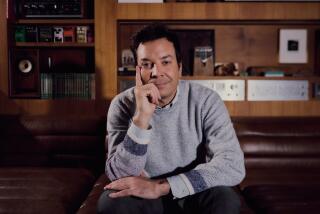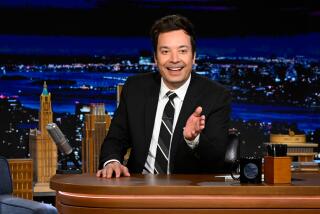Here’s Johnny, digitized: A searchable database created for Carson’s ‘Tonight Show’
Johnny Carson is getting an upgrade for the YouTube era.
Carson Entertainment Group, which owns the archive of the late-night host’s 30 years on “The Tonight Show,” is set to announce Wednesday that it has digitized all 3,300 hours of existing footage from the program and created a searchable online database for producers and researchers.
The library will initially be available just for professional clip-licensing purposes, but the company also plans to release 50 full-format shows on DVD and post a rotating series of historic clips for public viewing on https://www.johnnycarson.com.
The project was spurred by Jeff Sotzing, Carson’s nephew and president of Carson Entertainment, who said the continuing high demand for “Tonight Show” clips prompted him to seek a way to make the footage more accessible for both historic and commercial purposes.
“It’s amazing to me that even being off the air for 18 years, there’s still so much interest in this material,” he said.
Carson remains a singular figure because he served as a cultural touchstone during his three decades on the air, said Rick Ludwin, NBC’s executive vice president in charge of late-night series.
“That desk and that chair and the couch and the monologue and the band became as familiar as furniture in your own living room,” he said. “When any motion picture or documentary wants to put something in historical perspective, they often want to have a Johnny Carson joke from that era.”
That’s in part because Carson’s “Tonight Show” logged more than 22,000 guests during his tenure. “Everybody who was involved in public life seems to have appeared on that show,” said David Bushman, television curator at the Paley Center for the Media.
And the wry host, who died in 2005 at age 79, was viewed as a bellwether of public opinion: His jokes about Watergate marked a turning point for President Nixon.
Carson did not originally own the rights to his show, but was eventually able to negotiate full ownership in 1980 during a protracted contract dispute with NBC. At the time, “The Tonight Show” generated almost a fifth of the network’s profit from advertising revenue.
Before the digitization project, Carson Entertainment already had compiled a database listing the guests on each show and outlines of the topics of Carson’s daily monologue. But if producers wanted to find a mention of a subject or a person, they often had to screen hours of footage, hoping to stumble upon the right reference.
Now a searchable transcript of each show will allow researchers to instantly pull up the corresponding clip by typing a name, key word or date.
“I think it’s an extraordinary advancement in terms of using digital media in order to facilitate access of all different sorts,” said Bushman, who recently searched the museum’s Carson archives for a project on the late New York Mayor John Lindsay. “We had to do it the old-fashioned way. If we had had access to this, it would have been spectacular.”
Modern-day television shows are routinely converted to digital now and posted online, but the ease of search varies. Most networks keep internal transcripts of interview programs and newscasts, indexed with the corresponding time code of the footage. Some go further: On MSNBC.com, visitors can view searchable transcripts alongside individual clips, synced to the video. But the comprehensiveness of the Carson library exceeds that of most archives, including that of the current “Tonight Show,” which keeps transcripts of Jay Leno’s monologues, but not guest appearances.
The digitization process took about nine months and was done by Deluxe Archive Solutions, which works with many Hollywood studios to preserve their film and television libraries.
The video footage was trucked securely from where it had been stored in an underground salt mine in Kansas to a facility in Burbank, where a high-speed “tape robot” transferred each tape to a digital format. Then a team of transcribers logged more than 1 million words of dialogue and tagged each show by key word, guest and musical number.
“We feel we’re evangelists out there telling people this is what you are going to need to do in this new era of content consumption,” said Tyler Leshney, vice president of Deluxe Archive Solutions. “People don’t want to sift through two hours to find five minutes they’re searching for.”
The more searchable content, the more valuable it becomes, Leshney noted. Though researchers will have access to the Carson library for free, Carson Entertainment will charge a licensing fee to use each clip based on the type of project.
Not every moment of Carson’s reign on “The Tonight Show” is available. The original videos from 1962 to 1972 were recorded over by NBC at the time, a common practice then because tape was so expensive, Ludwin said. All that is left from that era are some grainy black-and-white kinescope clips, taken by a film camera pointed at a television set.
But the digitization process helped unearth some original footage thought to be lost, including a famous 1973 clip of Carson pretending to eat dog food during a live Alpo commercial after the dog refused the meal, before thought to exist only in grainy kinescope.
Such moments have the makings of instant viral videos, but Deluxe Archive Solutions took several security measures to ensure that the clips can’t be disseminated without permission, including embedding each with a large, yellow “Carson” watermark.
Sotzing said that Carson would have found the digitization project fascinating.
“He was a guy who loved technology and was always interested in watching old shows,” he said. “And the ability to get this stuff immediately, he’d love that.”
More to Read
The complete guide to home viewing
Get Screen Gab for everything about the TV shows and streaming movies everyone’s talking about.
You may occasionally receive promotional content from the Los Angeles Times.






